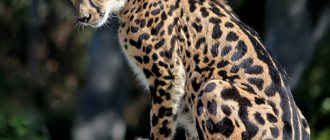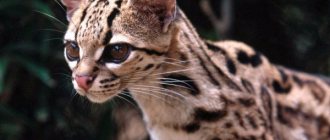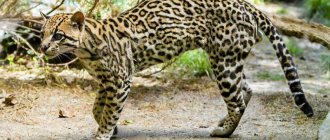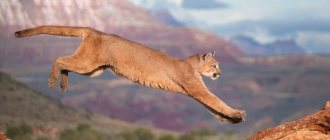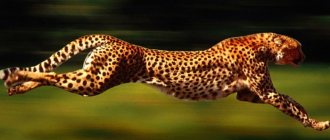Description
Jaguars are the largest and only panther cat native to the Americas. The height at the withers can reach 75 cm. The length of the body is 150-180 cm, and the length of the tail is 70-90 cm. Jaguars weigh between 68-136 kg. These are powerful animals, with large square jaws and large cheeks. They have a skinny body and muscular limbs. Their bodies are built for power, not speed, although they can develop good speed and pounce on unsuspecting victims with lightning speed. The coat color ranges from pale yellow to reddish brown, with black spots on the neck, body and legs. The belly is white with a gray tint. Black or melanistic jaguars are quite common and are the result of one dominant allele. These jaguars have black fur with black spots, which are usually difficult to see against a black background. Melanists are more common in forests.
The largest jaguars were recorded in the Panatal Nature Reserve in Brazil, where the average weight of males is 100 kg, and females - 76 kg. The smallest jaguars are found in Honduras, where males weigh on average 57 kg and females 42 kg. In general, jaguars found in dense forests are smaller in size than those found in open areas, perhaps due to the greater density of ungulates in open areas. Males are usually 10-20% larger than females. Dental formula I 3/3, C 1/1, PM 3/2, and M 1/1.
Characteristic
The jaguar, a photo of the animal confirms this fact, is one of the largest predators in North and South America. Its body is from 112 to 182 cm long without a tail. The tail itself grows up to 75 cm. Such a predatory animal weighs on average 60 - 90 kg. Adults weighing up to 120 kg are found. This cat family also has its own record holder, whose weight was 158 kg. Of course, females are not so large, they are about 20% smaller.
- In appearance, jaguars resemble leopards. These animals are often confused. Their coloring and markings are so similar that it is difficult for people to tell the difference.
- Jaguars are identified by their yellow or orange skins, dark spots and short legs. The dark spots look like roses and are called rosettes.
- A very rare melanist is the black jaguar, an animal whose photo will confirm that the color is not completely black. It has more black rosettes and very little reddishness. This helps the animal camouflage itself in the dense and dark forests of the Amazon.
Jaguars are identified by their yellow or orange skins, dark spots and short legs. Dark spots look like roses and are called rosettes
- Jaguars see 6 times better than humans at night or in dark conditions due to a layer of tissue at the back of the eye that reflects light.
- These cats are competent climbers and can climb trees. They often use them as a vantage point among the branches to pounce on carefree prey below.
- The jaguar is an apex predator. It does not have any natural enemies other than humans, who kill it for its fur or sport.
A very rare melanist is the black jaguar. Its color is not completely black. It has more black roses and very little reddishness
Habitat
Jaguars prefer dense, tropical rainforests, which provide them with ample cover, although they are also found in forested areas, reed beds, coastal forests, swamps and thickets. Jaguars are excellent swimmers and tend to live near water, such as rivers, lagoons, ponds and swamps. They are not usually found in dry areas. Jaguars have been recorded at altitudes of 3,800 meters in Costa Rica, but they are generally not found in mountain forests and do not live above 2,700 meters in the Andes. In northern Mexico and the southwestern United States, jaguars are found in oak forests, mesquite, and riparian forests.
Jaguars stalk their prey on the ground, preferring dense brush for camouflage. They can climb trees for their protection or while hunting. To maintain a healthy population, animals require a water supply, dense vegetation and sufficient prey.
Habitat range
Jaguars have a wide distribution, ranging from southern Arizona and New Mexico, south toward northern Argentina and northeastern Brazil. However, the population has been significantly reduced or eliminated in some regions, including El Salvador, the United States and large areas of Mexico.
Jaguars currently cover an area of approximately 8.75 million km2, or 46% of their historical range. Jaguars are most common in the Amazon River basin, including the Cerrado, Pantanal, and Chaco. Its range extends to the north and east of the Caribbean coast of Venezuela and Guiana. Population declines primarily occurred in northern Mexico, the United States, northern Brazil and southern Argentina. Populations have been wiped out in the Monte Desert in Argentina and the Pampa Steppe in southeastern South America. Jaguars are not typically found in higher elevations such as Pune.
Jaguars have their own range of habitats, which range from 25 to 38 km2 for females and almost twice as much for males. An adult male covers a range of 2-3 females. Males tend to travel further than females. According to one study, the average daily movement distance for males is estimated at 3.3 km, and for females at 1.8 km. They defend their habitats from other adult males.
The image of the jaguar in culture
In Indian mythology
In the cultures of pre-Columbian America, the jaguar, one of the most powerful predators in South America, received special attention and honor. The Olmecs identified themselves with the jaguar; he was the main hero of the Olmec cult and occupied a central place in the pantheon of gods. The image of a jaguar could be found on stone sculptures and altars of this people. The Maya, who lived in Central America, revered the jaguar (balam) as the first ancestor - three of the four first people were named B'alam K'itze (Cedar Jaguar), B'alam Aq'ab (Night Jaguar) and Ik'ib' alam (Dark Jaguar). As a symbol of power, leaders wore jaguar skins and helmets in the shape of their heads. In Aztec culture, the god Tezcatlipoca often took the form of a jaguar, whose spotted skin represented the pattern of the starry sky.
In literature
Borges tells the story of the Aztec magician Tsinacan, who reads the incorruptible writings left by God on the skin of a jaguar. According to the author, the skin represents the most reliable information carrier at God’s disposal.
The story "The Brazilian Cat" by Arthur Conan Doyle describes a melanistic jaguar.
In sports
- Jaguar is an automobile company best known for producing high-end sports cars; In Formula 1, there was a team representing this company for several years.
- The Mexican Top Division football club is called Jaguares Chiapas.
- The American football club in the United States is called the Jacksonville Jaguars.
Reproduction and Life Cycle
Jaguars most often communicate through vocalizations. During estrus, females communicate in the morning and late at night that they are ready to mate. Males respond to these calls with vocalizations of their own and travel to the female's territory to copulate, leading to competition between males to mate with a particular female. It is not uncommon for a female to copulate with multiple males, although a dominant male may chase off a weaker opponent. Females do not tolerate the presence of males after mating and especially after the birth of cubs.
The estrus cycle typically repeats after 37 days and is between 6 and 17 days long. Estrus is characterized by the following features: lordosis (deep curvature of the spine), flehmen (lip movement), vocalizations, rolling and increased aromatic markings. Males show increased androgen levels year-round, but the hormone levels peak during flood waters in some areas. Jaguars can produce offspring year-round, but mating typically increases from December to March. Most of the cubs are born during the rainy season, when prey is more abundant. On average, a female gives birth to 2 cubs (the number varies from 1 to 4). Pregnancy lasts 91-111 days. Reproduction in females occurs at 12-24 months, and in males at 24-36 months.
Cubs are born with their eyes closed and are completely dependent on their mother. Their eyes open for about two weeks. They are fed with mother's milk until they reach 5-6 months of age. Then they begin to hunt with their mother. The cubs depend on their mother for almost two years. She protects them from predators, teaches them to hunt and instills all the necessary skills.
Jaguars in the wild live 11-12 years. Disease, accidents, collisions with other wild animals or poaching are the main sources of mortality. In captivity, jaguars can reach 20 years of age.
Along with tigers and lions, jaguars belong to the panther genus. Jaguars live only in the countries of the New World - in South and Central America.
2. The largest habitats of jaguars are the jungles of Central America and the ocean coast of Argentina.
3. Previously, these animals were very common in South America, but recently the population of these predators has decreased by 3 times.
4. In countries such as El Salvador and Uruguay, this large cat has been completely exterminated. Currently, the predator is listed in the Red Book.
5. Experts count 9 species of jaguars: Amazonian; Peruvian; Paraguayan; Mexican; Texan; Arizonan; Central American; Brazilian; Goldman. The Texas jaguar is considered extinct.
6. The color of the jaguar is very similar to the color of other representatives of the cat family - ocelots, cheetahs and leopards.
7. The color of the animal is sandy-red. The belly and the inside of the paws are white. Dark spots in the form of dots, rings and rosettes are scattered throughout the body. The fur is short and thick. The jaguar has short powerful legs, which makes it a little squat, but this does not interfere with its agility at all.
8.Jaguars are the third largest of all big cats after tigers and lions. The body length of adult jaguars without a tail ranges from 120 to 190 centimeters, and their weight rarely exceeds 120 kilograms.
9. Many people confuse jaguars with leopards, but jaguars are much larger and stronger than leopards, although these animals are very similar in appearance.
10. The name “jaguar” most likely comes from a similar-sounding word from the Guarani language, spoken by Indians in what is now Paraguay. This word is translated as “a beast that kills with one blow.”
11. The spotted color of a jaguar is as unique as the pattern on a person’s fingers. In nature, there are no two absolutely identical predators, even if they are relatives.
12. At one time, many Indian tribes worshiped jaguars, considering them sacred animals.
13. The ancient Mayans believed that jaguars were a symbol of the power of the gods. The best Mayan warriors in ancient times called themselves jaguars. Only they were allowed to wear clothing made from the skin of this beast.
14. In some Indian tribes, there was a tradition of tying special tablets to the foreheads of small children so that their heads would look like a jaguar skull.
15. The ancient Mayans believed that the animal was capable of hypnotizing its victim and depriving it of the ability to move.
16. The most unusual representative of these predators is the black jaguar - an animal that is mistakenly called a panther. Panther is not considered a separate species, it is the name of a biological genus.
17. A black jaguar is just a manifestation of melanism, that is, it is an individual with a genetic variant of atypical coloring.
18. Different species of jaguars live in different areas. However, they have a similar lifestyle.
19. The oldest jaguar fossil ever found lay in the ground for about two million years.
20. The animal’s habitat is a triangle with an area of 30-100 km². Females have less space, while males have more.
21. Three times a month, a predator walks around the borders of its territory. Good speed allows him to do this quite quickly.
22. The hunting grounds of jaguars often overlap. The nature of the predator is such that it calmly treats its fellows, but is very hostile towards other representatives of the cat family on its territory.
23. Unlike the cheetah, which prefers to attack its prey with a swift dash, jaguars attack from ambush.
24. Jaguars cannot interbreed with other species of the cat family. The exception is lions. True, the offspring obtained in this way are born sterile, without the ability to reproduce further.
25. This cat often attacks livestock.
26. Jaguars are exclusively nocturnal, preferring to sleep somewhere in a shelter during the day. The jaguar hunt begins at night. The animal tries to catch prey in one place for several days, and then moves to another part of the territory.
27. Since the jaguar lives in impenetrable jungles, mountains or on the ocean coast, its food can be both birds and artiodactyls. The animal usually hunts wild pigs, deer, foxes, roe deer and rodents.
28. The area where the jaguar hunts can be of incredible size. So, sometimes it reaches up to 500 kilometers. And this is not surprising, because the jaguar is a freedom-loving animal.
29. These large cats have strong jaws, so they kill prey, as a rule, by grabbing the neck, trying to knock the victim down.
30. Jaguars are great swimmers. There is evidence that they swam vast distances - tens of kilometers. To overcome water obstacles, jaguars often use logs in the same way as a person would use them - they cling to them and row.
31. The main trump card of these cats is speed, so rare prey manages to escape. Neither trees nor water can become a refuge, since jaguars are excellent swimmers and climb trees.
32. There have been recorded cases of jaguars attacking even large anacondas, which are the largest snakes on the planet.
33. Jaguars sometimes even attack crocodiles, although mostly on young animals - an adult crocodile is too dangerous for this proud representative of the cat family.
34. Jaguars can imitate the voices of monkeys in order to lure their relatives. In particular, the researchers observed how a jaguar imitated the cries of a baby monkey. The adult monkeys rushed to help, but, fortunately for them, they noticed the predator in time and disappeared.
35. Jaguars eat food in 2 approaches with a break of 10-12 hours. Predators can simply throw away the remains of a killed animal and not return to them.
36. Puberty in these cats occurs at 3 years. Since then, predators can mate at any time, since they do not have a specific breeding season.
37. It happens that during the mating season they gather in groups in one place. The female chooses a mate for herself and comes to the territory where the male lives.
38. The largest individuals, whose body length reaches almost 2 meters, live in the jungles of Brazil. The mass of these animals is more than 100 kg, but on average jaguars weigh 80-90 kilograms. Males are larger than females.
39. These predators hunt from ambush, looking out for their prey during a watering hole or meal. They attack from the side from which the victim may not immediately notice the approaching animal.
40. The duration of pregnancy in jaguars is 100-110 days. Usually 1-4 cubs are born.
41. For the first year after birth, a jaguar cub is very closely connected with its mother, so it does not lag behind her one step.
42.As a rule, after birth, jaguars live with their mother for 2-3 years. During this time, they learn from their mother the skills of hunting and survival.
43. The largest jaguar ever encountered by researchers weighed 158 kilograms. But usually jaguars weigh less - in the range of 100-120 kilograms.
44. Jaguars are able to cope with almost any prey, while they are extremely secretive and inventive.
45. It is almost impossible to see a jaguar if it does not want to - any wildlife researcher can confirm this.
46. If several animals are found in one territory, then, as a rule, these are a female and her young offspring.
47. Zoologists say that these animals are very curious, but are not particularly aggressive.
48. Despite their good speed, jaguars do not always pursue their prey if it tries to escape.
49. Jaguars attack people extremely rarely, mainly only in case of self-defense. Known cases of attacks were mainly provoked by the people themselves.
50. There are no natural obstacles for these animals. They can live in mountain forests at an altitude of 2 kilometers, climb in impenetrable jungles, sleep in trees and overcome water obstacles.
photo from the Internet
Behavior
Jaguars are most active in the evening and at dawn, although they can be active at any time of the day. As a rule, they rest during the day. When resting, jaguars lie in deep shade, under dense vegetation, in caves or under large rocks. They also rest near river banks, and during the rainy season they are forced to perch on trees. Jaguars are highly dependent on water, especially during dry periods when they need to escape the water. These are solitary animals except during the breeding season.
Communication and perception
Jaguars primarily communicate through vocalizations. It increases in tone or power and differs depending on the individual making the sound, whether male, female, or female in heat. Males have more powerful vocalizations than females. During estrus, females call late at night and at dawn. The male's response to the female's call is more hoarse and guttural. Hunters sometimes imitate the sounds of a female to attract a male. Jaguars mark territory with vocalizations, mark trees, and defecate on vegetation.
Nutrition
Jaguars are strictly carnivorous mammals. They have a rich diet, over 85 species have been recorded as jaguar food. Preferred prey are large animals such as peccaries, tapirs and members of the deer family. They also hunt caimans, turtles, snakes, porcupines, capybaras, fish, birds and other animals. Jaguars usually attack prey from a secluded place. They make a direct bite to the neck and then strangle the victim or kill it instantly by piercing the back of the skull with their fangs. Their powerful jaws and fangs allow them to kill thick-skinned reptiles and bite through turtle shells. Then, the jaguars drag their prey to a secluded place and enjoy the food.
What does a jaguar eat?
The jaguar is a carnivorous animal that prefers to eat various small representatives of the fauna. The jaguar's favorite prey is the caiman or capybara. If these representatives are not on their territory, then the jaguar can hunt animals such as deer, snakes, various birds and fish.
Jaguar also hunts snakes
They prefer foxes, monkeys, and black caimans as larger prey. The jaguar does not mind eating a turtle; it is able to bite through the shell without much effort. If there are farms in the jaguar's habitat, it can also attack livestock. Thanks to his outstanding physical abilities, it is almost impossible to get out of a fight with a jaguar alive. Even in water, this animal can easily attack prey. When hunting, it prefers to hide in ambush near the shore of a reservoir covered with tall grass. It attacks from the back and grabs the neck, giving no chance of escape.
Jaguar attack on caiman
Economic significance for humans
Positive
Jaguars are predators and key species in the ecosystems they inhabit. Their skins and furs are sold for profit, despite the ban on hunting in most countries. Enforcement of laws protecting jaguars has improved in recent years. Jaguars are also an important source of income in ecotourism for local communities where there are opportunities to observe them.
Negative
Jaguars sometimes prey on cattle and other farm animals, leading to persecution by herders. Some countries, such as Brazil, Costa Rica, Guatemala, Mexico and Peru, have not banned hunting only for “problem” jaguars that repeatedly kill livestock. Bolivia allows trophy hunting of jaguars. Jaguars do not attack people without provocation.
Natural enemies
The most important and dangerous enemy for a jaguar is a person who hunts it for its beautiful fur. In nature, this king of the jungle has virtually no competitors or threats: in its habitat it is the highest in the food chain.
Important! It can fight for territory with large cougars, usually dominating them, but sometimes receiving serious injuries.
During the hunt, jaguars sometimes encounter serious and dangerous opponents - caimans, although they pull even 2-meter monsters out of their native element. When hunting large reptiles, they can occasionally become a victim of an anaconda or a boa constrictor.
Return to content
Subspecies
There are three main subspecies of jaguars:
1. Panthera onca onca – Venezuela, although the Amazon is also included. 2. Panthera onca hernandesii – (Mexican jaguar): Northern Mexico. The Mexican jaguar includes the following 4 subspecies: - Panthera onca centralis (Central American jaguar): from El Salvador to Colombia. - Panthera onca. arizonensis (Arizona jaguar): Southern Arizona to Sonora, Mexico. - Panthera onca. veraecrucis: Central Texas to southeastern Mexico. — Panthera onca goldmani: from Yucatan to Belize and Guatemala. 3. Panthera onca palustris (largest subspecies, reaching a weight of about 135 kg): Pantanal region of Mato Grosso and Muto Grosso do Sul, Brazil along the Paraguay River and northeastern Argentina.


